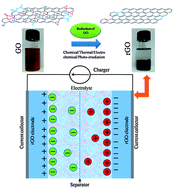Recent advances in the efficient reduction of graphene oxide and its application as energy storage electrode materials
Abstract
Efficient reduction of graphene oxide (GO) by chemical, thermal, electrochemical, and photo-irradiation techniques has been reviewed. Particular emphasis has been directed towards the proposed reduction mechanisms of GO by different reducing agents and techniques. The advantages of using different kinds of reducing agents on the basis of their availability, cost-effectiveness, toxicity, and easy product isolation processes have also been studied extensively. We provide a detailed description of the improvement in physiochemical properties of reduced GO (RGO) compared to pure GO. For example, the electrical conductivity and electrochemical performance of electrochemically obtained RGO are much better than those of chemically or thermally RGO materials. We provide examples of how RGO has been used as supercapacitor electrode materials. Specific capacitance of GO increases after reduction and the value has been reported to be 100–300 F g−1. We conclude by proposing new environmentally friendly types of reducing agents that can efficiently remove oxygen functionalities from the surface of GO.


 Please wait while we load your content...
Please wait while we load your content...